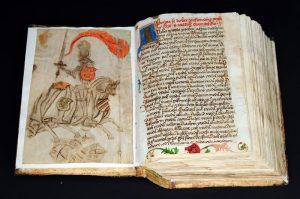 Prophets of Cieszyn Prophets of Cieszyn
The code originating from 1418-1439 contains the Books of Prophets and New Testament translated into Czech language. In the second part of 15th century it was owned by Hynek Birka of Nasile, whose portrait on a horse painted on parchment, identified with the knight’s ex libris was attached at the beginning of the code. Count Jan Larisch-Mönnich presented the code to the library of Leopold Jan Szersznik. In the course of time the code has been called Prophets of Cieszyn, because of the place where it was stored. |
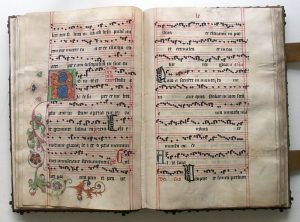 Marian Gradual Marian Gradual
One of the three parts of so called Gradual of Tarnów is one of the most precious polonica owned by Cieszyn Library. Richly illuminated parchment code originating from the third decade of 16th century contains, among others, one of the oldest known notations, two Latin and one Polish language version of Bogurodzica, the song which was recognised as the first national anthem of Poland.
|
 Ius municipale Brunnense, Nürnberg ca 1498 Ius municipale Brunnense, Nürnberg ca 1498
The oldest issue of the municipal law of Brno kept in Leopold Jan Szersznik library is the only issue of this edition registered in Poland.
|
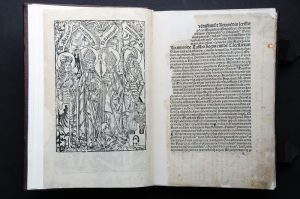 Co[m]mune incliti Polonie Regni privilegium, Cracow 1506 Co[m]mune incliti Polonie Regni privilegium, Cracow 1506
Privileges, constitution, legal documents and acknowledged decrees of the Highest Kingdom of Poland (Przesławnego Królestwa Polskiego przywileje, konstytucje i zezwolenia urzędowe oraz uznane dekrety) known also by the name of their writer, Jan Łaski Grand Chancellor and Primate of Poland – Łaski’s Statute were the result of the attempt to order Polish law, the decision was passed by the Seym in Radom in 1505. The Statute was developed on the order of King Alexander Jagiellon and the Seym and printed in 162 copies in the Cracow publishing house of Jan Haller. The Statute became the basic collection of legal acts regulating the life of Polish Republic of nobility era in subsequent centuries. |
 Super ex libris of Sigismund Augustus (1520-1572)(Hieronymi Cardani medici mediolanensis Libelli qinq, Norimbergae 1547) Super ex libris of Sigismund Augustus (1520-1572)(Hieronymi Cardani medici mediolanensis Libelli qinq, Norimbergae 1547) |
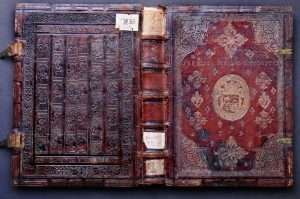 Super ex libris of Jan Ponętowski (+1598)(Ioannes Calderinus, Concordantia, sive Ambidexterium, Spirae 1481) Super ex libris of Jan Ponętowski (+1598)(Ioannes Calderinus, Concordantia, sive Ambidexterium, Spirae 1481) |
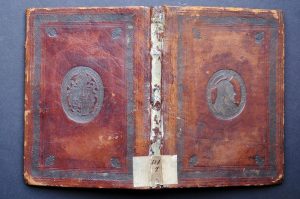 Super ex libris of Stanisław Pawłowski (+1598) Acta et constitutiones synodi olomucensis, anno… M. D. LXXXXI die XII novēbris habitae et celebratae, Olomutii 1592) Super ex libris of Stanisław Pawłowski (+1598) Acta et constitutiones synodi olomucensis, anno… M. D. LXXXXI die XII novēbris habitae et celebratae, Olomutii 1592)
Among the rare books owned by Cieszyn Historical Library, not only are there literary texts and printing specimens, but also books precious because of their provenience: manuscripts and prints originating from the libraries of known personalities, containing their markings of ownership. The latter include super ex libris of the king of Poland Sigismund II Augustus, bishop of Olomouc Stanisław Pawłowski of Pawłowice, or the abbot of Premonstratensians from Klášterní Hradisko, Jan Ponętowskiego of Ponętów. |
 Prayer book of the duchess Elizabeth Lucretia Prayer book of the duchess Elizabeth Lucretia
A miniature (4×4,5 cm) prayer book printed on parchment owned by Duchess Elizabeth Lucretia contains the prayers written down in 15th or early 16th century, as well as some which were added later, in the second half of 16th century, or at the beginning of 17th century. Apart from one prayer in Czech language, all the other prayers are in German. The code is decorated with 5 full page illuminations. The prayer book is the only book owned by Cieszyn Piast Dynasty, which survived to contemporary times.
|
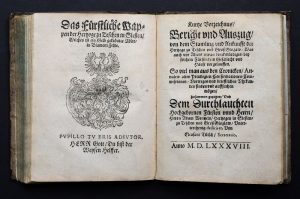 Eleazar Tilisch, Kurtze Vorzeichnus, Bericht vnd Auszug von dem Stamling vnd Ankunfft der Hertzoge zu Teschen vnd Groß Glogaw, Freybergk in Meissen 1588 Eleazar Tilisch, Kurtze Vorzeichnus, Bericht vnd Auszug von dem Stamling vnd Ankunfft der Hertzoge zu Teschen vnd Groß Glogaw, Freybergk in Meissen 1588
The work of Eleazar Tilisch (1560-1612), secretary of the duchess Sidonia Catharine (1550-1594) dedicated to the history of Cieszyn Piast dynasty is considered to be the first essay about the history of the region. The work was based not only on the earlier chronicles, but also on the sources found in the duchess’ archive. |
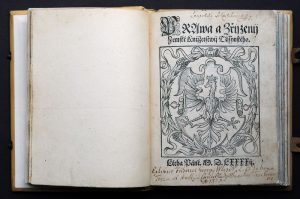 Prawa a zřijzenij zemské Knijžetstwij Těssynského, Holomauca 1592 Prawa a zřijzenij zemské Knijžetstwij Těssynského, Holomauca 1592
Estate Regulation of the Duchy of Cieszyn written down in 1573 on the order of Duke Wenceslaus III was designed to regulate the legal relationship between the duke and local nobility. It had long been contested by the Cieszyn states, to be finally approved in 1591, and until the half of 19th century it was the basic legal act regulating the lives of the citizens of the Duchy of Cieszyn. |
 Sebastian Petrycy, Aristotle Politics, that is the governing the country with the addition of eight books, Cracow, 1605 (Polityki Aristotelesowey to iest rządv rzeczypospolitey z dokładem ksiąg ośmioro, Kraków 1605) Sebastian Petrycy, Aristotle Politics, that is the governing the country with the addition of eight books, Cracow, 1605 (Polityki Aristotelesowey to iest rządv rzeczypospolitey z dokładem ksiąg ośmioro, Kraków 1605)
Dedicated to the duke of Cieszyn, Adam Wenceslaus (1574-1617) and the king of Poland Sigismund III Vasa translation of the Aristotle’s Politics which was translated and provided with comments adapting Aristotle’s work to Polish conditions by Sebastian Petrycy, doctor and philosopher of Cracow. |
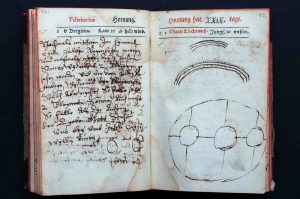 Johann Tilgner, Tagebuch Johann Tilgner, Tagebuch
Deriving from the Wrocław nobility, Jan Tilgner (1574 – after 1635), ducal graphic of Strumień and Skoczów was a member of social and cultural elite of the Duchy of Cieszyn. He was closely connected with the duke’s court and left a diary in German, which contained information about the history of his family, society, and the court, starting from 1590’s until 1635. The drawing and description which can be seen on the reproduction show the phenomenon of the halo effect which was observed by the author on Ash Wednesday of 1620 in Skoczów. |
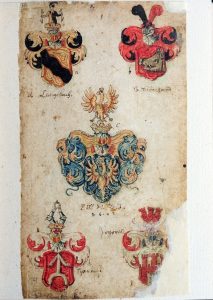 Goczałkowski’s armorial Goczałkowski’s armorial
The armorial originating from the break of 16th and 17th centuries contains the representation of few hundred coats of arms of nobility of the Upper Silesia, mostly of Cieszyn region; of Polish and German families, as well as the pictures of the dynasty coats of arms from Silesia, Poland, Courland and Pomerania. The code was presented to the Library of Leopold Jan Szersznik by Baron Maksymilan Goczałkowski. In the literature of the subject the code is often described as Goczałkowski’s Armorial, the name coming from the family name of the benefactor. |
 Kniha Meuster-stuka Czechu Kreiczirskiho miesta Tzessina od Knizetie Watzlawa spasitelney pamienczi won tczas w roku 1564 udielne a priwiligirowane 16 kussuw Kniha Meuster-stuka Czechu Kreiczirskiho miesta Tzessina od Knizetie Watzlawa spasitelney pamienczi won tczas w roku 1564 udielne a priwiligirowane 16 kussuw
The book of masterpieces of the Cieszyn tailors’ guild originates from the middle of 17th century. In 1686 it was donated to the tailors’ guild of Jabłonkowo and was used there until the middle of 19th century. The book contains 16 patterns of various elements of liturgical attire, men’s and women’s garments, as well as shabracks and tents. |
|
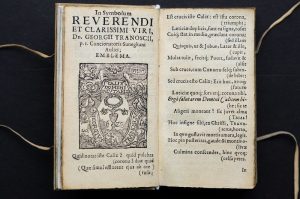 Jerzy Trzanowski, Odarum sacrarum sive Hymnorum…libri tres, Bregae 1629 Jerzy Trzanowski, Odarum sacrarum sive Hymnorum…libri tres, Bregae 1629
Jerzy Trzanowski (1582-1637), Lutheran clergyman coming from Cieszyn is the author of several anthologies of prayers and songs. The most famous of them, Cithara Sanctorum was reprinted more than 150 times and was used in Silesian, Slovak, Moravian and Czech churches even in 20th century. The earliest of them, and currently kept in limited number of copies collection Odarum sacrarum, was fitted with the emblem including the author’s portrait. Because of the significance of his works, Trzanowski was dubbed „Slavic Luther” by evangelic Congregationalists.
|
|
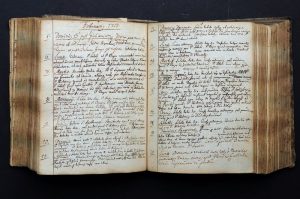 Diarium Residentiae S. I. Teschinensis ab Anno 1707-1717 Diarium Residentiae S. I. Teschinensis ab Anno 1707-1717
The biggest contribution into the conversion to Catholicism comes from Jesuit monks, who have been present in Cieszyn from 1671. In the library of Leopold Jan Szersznik, who managed to take over and include into his own collection major part of the library and archive of Cieszyn residence of the Jesuit Society, we can admire a full set of diaries originating from 1707-1772.
|
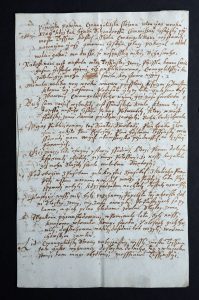 Jakub Galacz, Pisniczka pobożna ewangelitska slożena w ten czas 1709 kdyż tak hrabie Sytzendorffu komisarz cysarzski przi meste Tessyne kostel a sskolu ewangelikum wystawiti naweczne czasy gmenem cysarze placz pokazal a oddal Jakub Galacz, Pisniczka pobożna ewangelitska slożena w ten czas 1709 kdyż tak hrabie Sytzendorffu komisarz cysarzski przi meste Tessyne kostel a sskolu ewangelikum wystawiti naweczne czasy gmenem cysarze placz pokazal a oddal
|
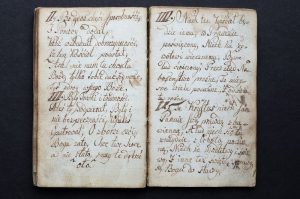 Jan Michalik, Song for the consecration of the church in Bystrzyca (Pieśń ku poświęceniu kościoła bystrzyckiego) Jan Michalik, Song for the consecration of the church in Bystrzyca (Pieśń ku poświęceniu kościoła bystrzyckiego)
Peasants from Cieszyn engaged themselves into the erection of Lutheran churches and the life of particular congregations. One of them, free peasant farmer of Cierlick, Jakub Galacz not only took part in collecting funds to erect the church, but also wrote a song which in a detailed way described the events which led to building of the Church of Mercy in Cieszyn. Supposedly he was to order and pay for the print of – unknown at that time – Katechizm ze ślabikorzem (Catechism with the alphabet book) for the evangelical school in Cieszyn. A few dozen years later, another peasant, Jan Michalik wrote a song for the consecration of the evangelic church in Bystrzyca, built in 1782, after issuing the Edict of Tolerance by Emperor Joseph II. |
 Jan Muthmann, Faithfulness to God and the Emperor, of the times of pestilence, in Brzeg 1716 (Jan Muthmann, Wierność, Bogu y cesarzowi, czasu powietrza morowego należąca, Brzeg 1716) Jan Muthmann, Faithfulness to God and the Emperor, of the times of pestilence, in Brzeg 1716 (Jan Muthmann, Wierność, Bogu y cesarzowi, czasu powietrza morowego należąca, Brzeg 1716) |
 Prayers translated from Italian into German, and from German to the usual language of the Duchy of Cieszyn, in Brno 1788 (Modlitwy z wloskiego przetłumaczone na jenzyk niemiecky a z niemieckiego na ten, ktory jest w Xionżenstwie Tieszynskim zwyczayny, Brno 1788) Prayers translated from Italian into German, and from German to the usual language of the Duchy of Cieszyn, in Brno 1788 (Modlitwy z wloskiego przetłumaczone na jenzyk niemiecky a z niemieckiego na ten, ktory jest w Xionżenstwie Tieszynskim zwyczayny, Brno 1788)
In the 18th century, Silesian and Moravian printing houses printed several religious publications in Polish language, intended for the citizens of the Duchy of Cieszyn. The oldest of them, a modest booklet which makes a peculiar combination of medical handbook and prayer book, was written by the first reverend of Cieszyn who was supervising the construction of the Church of Mercy, Jan Muthmann (1685-1747). Among the Catholic prints, it is worth to mention extremely rare prayer book, whose characteristic title was often mentioned as one of the spectacular pieces of evidence of that time dominance of Polish language in Cieszyn Silesia. |
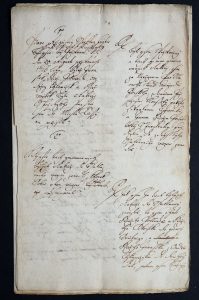 Reports and declarations of the municipal jurors and surgeons on the account of hearing four robbers from the Frydeck country by juror court in Cieszyn, in August of 1716. (Sprawozdania i oświadczenia ławników miejskich oraz miejskich chirurgów (felczerów) w sprawie przebiegu przesłuchania przez sąd ławniczy w Cieszynie w sierpniu 1716 r. czterech zbójników z państwa frydeckiego) Reports and declarations of the municipal jurors and surgeons on the account of hearing four robbers from the Frydeck country by juror court in Cieszyn, in August of 1716. (Sprawozdania i oświadczenia ławników miejskich oraz miejskich chirurgów (felczerów) w sprawie przebiegu przesłuchania przez sąd ławniczy w Cieszynie w sierpniu 1716 r. czterech zbójników z państwa frydeckiego)
The character of Andrzej Szebesta (1680-1715), famous robber of the Beskidy region, known by the name of Ondraszek transpired into Polish and Czech literature. Ondraszek activity took place at the same time when Juraj Janosik (1688-1713) was engaged in his criminal activity. In the library of Leopold Jan Szersznik one can find documents originating from the municipal archive, which are connected with the arrests and hearings of the robber’s accomplices, including Jerzy Juraszek, who tempted by high bounty killed his chieftain during a dance party in a tavern. At first he was rewarded with the money, then one year later he was lured into Cieszyn prison and sentenced to breaking on the wheel. |
 Paweł Szurman, Chronicle of the Duchy of Cieszyn (Paweł Szurman, Kronika Księstwa Cieszyńskiego) Paweł Szurman, Chronicle of the Duchy of Cieszyn (Paweł Szurman, Kronika Księstwa Cieszyńskiego)
In the Cieszyn collections there are many traces of so called „scribblers” (piśmiorze) – peasants who at the break of 18th and 19th centuries not only knew how to read and gathered books but also wrote their own journals „zapiśniki”, in which they noted information concerning their families, villages or even the whole of the Duchy. Today, these journals not only show the evidence of the high level of the peasant culture in Cieszyn Silesia region, but also show the process of forming the regional identity of local people – which, regardless of the ethnical differences – survived until present day. Knowledge about the history of the region spread by duplicates, often extended with additional information, of the chronicle of the Duchy played particularly important role in this process. The chronicle was written in 1720 by Johan Früschmann of Saxony. One of its versions is the list of more important dates of the history of Cieszyn Silesia, written down in the middle of 19th century by the peasant of Leszna Dolna, Paweł Szurman. |
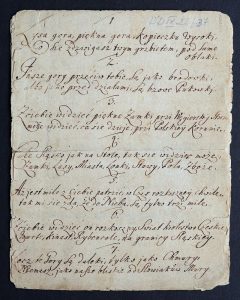 Ludwik Heimb, Łysa Góra Ludwik Heimb, Łysa Góra
It is hard to define the date when the regional identity of the local people was accompanied by feeling of love to their „small motherland”. The only thing that is sure is that the first author, who decided to include his feelings of attachment to the homeland in his writings and celebrate its beauty, was Catholic priest born in Cieszyn, Ludwik Heimb (c. 1700-1765) who served as preceptor of Leopold Jan Szersznik. One of his poems is dedicated to the highest peak in Cieszyn Silesia, Łysa Góra.
|
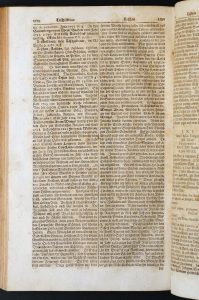 Grosses vollständiges universal Lexicon aller Wissenschafften und Künste. Zwey und Viertzigster Band: Taro – Teutschep, Leipzig und Halle 1744 Grosses vollständiges universal Lexicon aller Wissenschafften und Künste. Zwey und Viertzigster Band: Taro – Teutschep, Leipzig und Halle 1744 |
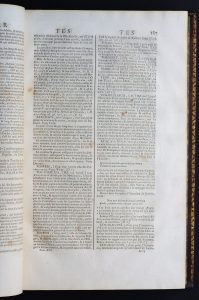 Encyclopédie, ou dictionnaire raisonné des sciences, des arts et des métiers. Tome sezieme: Te-Venerie, A Neufchastel 1765 Encyclopédie, ou dictionnaire raisonné des sciences, des arts et des métiers. Tome sezieme: Te-Venerie, A Neufchastel 1765
The set of Cieszyn Library includes a large collection of encyclopaedic publications, whose pride are complete issues of the Encyclopaedia, or a systematic dictionary of the sciences, arts, and crafts and a little less known but earlier and wider 68–volume (including the supplement) Saxon Encyclopaedia by Johann Heinrich Zedler. Both works contain comprehensive entries dedicated to Cieszyn, which in the case of Grosses vollständiges universal Lexicon occupies as many as four pages.
|
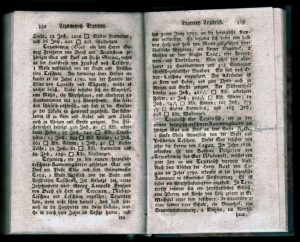 Reginald Kneifel, Topographie des kaiserl[ich] königl[ichen] Antheils von Schlesien, Bd. 1, T. 2, Brünn 1804 (part of the entry about city of Trzyniec) Reginald Kneifel, Topographie des kaiserl[ich] königl[ichen] Antheils von Schlesien, Bd. 1, T. 2, Brünn 1804 (part of the entry about city of Trzyniec)
|
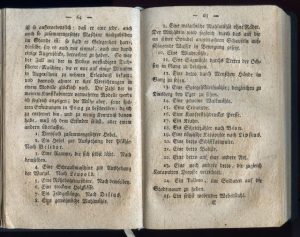 Leopold Jan Szersznik, Nachrichten von Schriftstellern und Künstlern aus dem Teschner Fürstenthum, Teschen 1810 (part of the entry concerning Jan JózefaBożek 1782-1835, born in Biery near Skoczów, renowned Prague inventor, at some time apprentice of Leopold Jan Szersznika) Leopold Jan Szersznik, Nachrichten von Schriftstellern und Künstlern aus dem Teschner Fürstenthum, Teschen 1810 (part of the entry concerning Jan JózefaBożek 1782-1835, born in Biery near Skoczów, renowned Prague inventor, at some time apprentice of Leopold Jan Szersznika) |
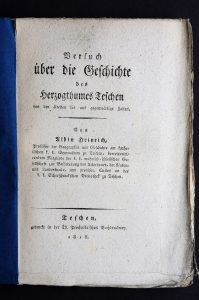 Albin Heinrich, Versuch über die Geschichte des Herzogthumes Teschen von den ältesten bis auf gegenwärtige Zeiten, Teschen 1818 Albin Heinrich, Versuch über die Geschichte des Herzogthumes Teschen von den ältesten bis auf gegenwärtige Zeiten, Teschen 1818
From the beginning of 19th century, monographs about Cieszyn Silesia started to be published. The first item on the list is the topography of Austrian Silesia, by Reginald Kneifl (1761-1826) of Opawa region. Second part of his work is completely dedicated to the Duchy of Cieszyn. Apart from comprehensive data concerning the villages and settlements of the area, the monograph contains information about the then range of Polish and Moravian-Silesian dialects. Another work issued at that time is biographical dictionary of Cieszyn Silesia, prepared by rev. Leopold Jan Szersznik on the occasion of the millennial anniversary of establishing Cieszyn. The first successor of Leopold Jan Szersznik on the post of the custodian of his collection was Albin Heinrich (1785-1864) of Frýdlant over Moravicí, who later became the custodian of Francis Museum in Brno, at his time he was the greatest Moravian scholar. He realized the plans of the library’s founder and in 1818 published the first synthesis of the history of the Duchy of Cieszyn. |



























